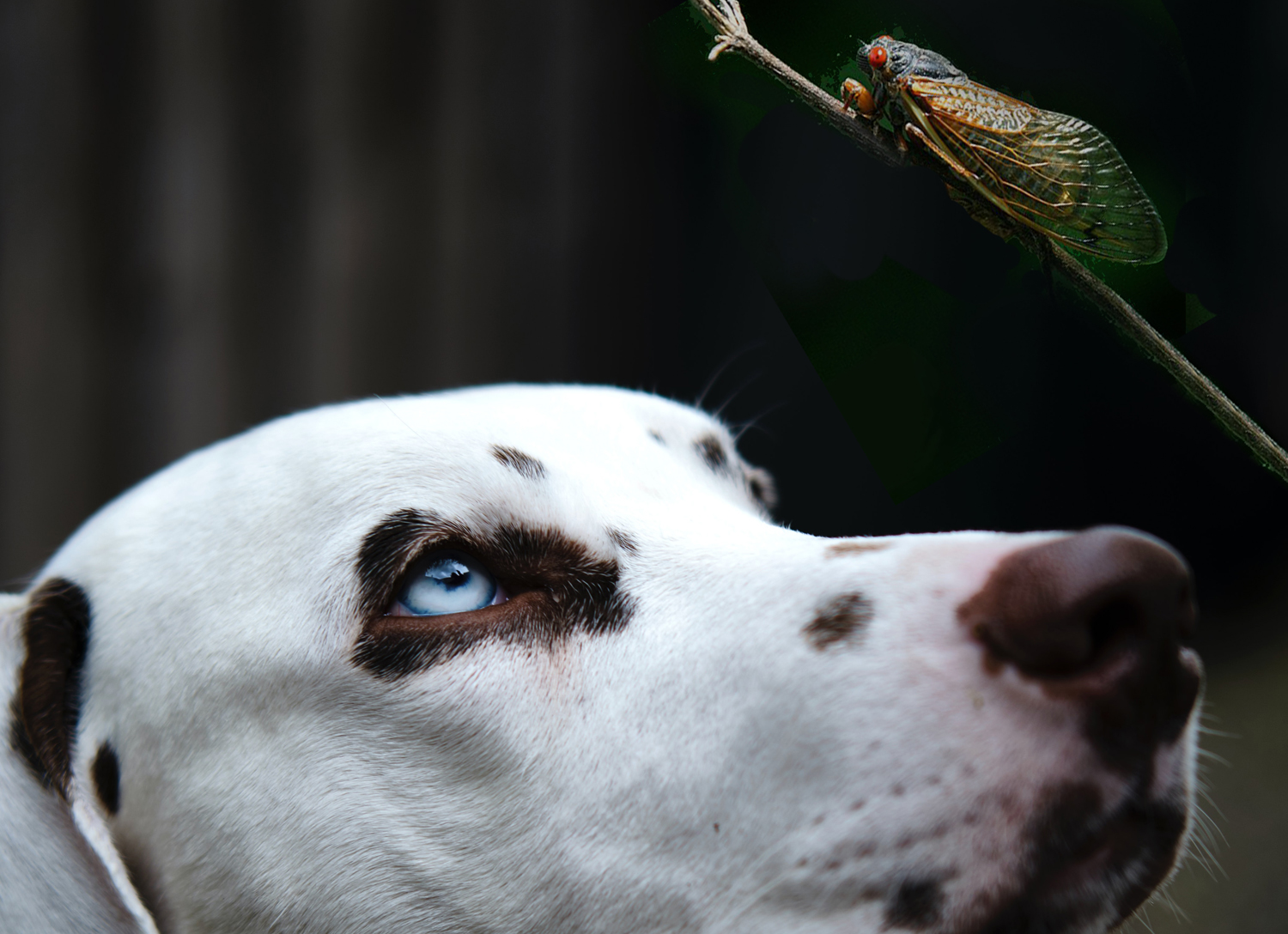
Brood X, as the summer of 2021’s swarm of cicadas is called, is supposed to be a big crop. In the trillions! Most dogs are naturally drawn to these little critters because they move quickly, make noise, and are within reach. So, do these bugs offer any harm to your pup?
There’s a lot being written on this subject lately and the consensus is “no”, cicadas are not dangerous to you or your dog.
However, there are some dogs that eat a lot of them, and that can be hazardous. The exoskeleton is basically a hard shell that can have sharp edges when consumed and it can irritate the digestive tract. Some dogs puke, or have diarrhea, after eating only one. Some dogs can eat many without issues.
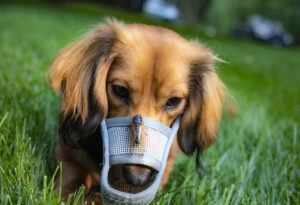 Here’s a story about a dog that can’t eat enough of the big bugs. His owner wrote this funny article in The Washington Post, told from the dog’s point of view.
Here’s a story about a dog that can’t eat enough of the big bugs. His owner wrote this funny article in The Washington Post, told from the dog’s point of view.
The Brood X cicada population is impressive but short-lived.
Trillions of cicadas are emerging in Delaware, Georgia, Illinois, Indiana, Kentucky, Maryland, Michigan, North Carolina, New Jersey, New York, Ohio, Pennsylvania, Tennessee, Virginia, West Virginia and Washington, D.C.
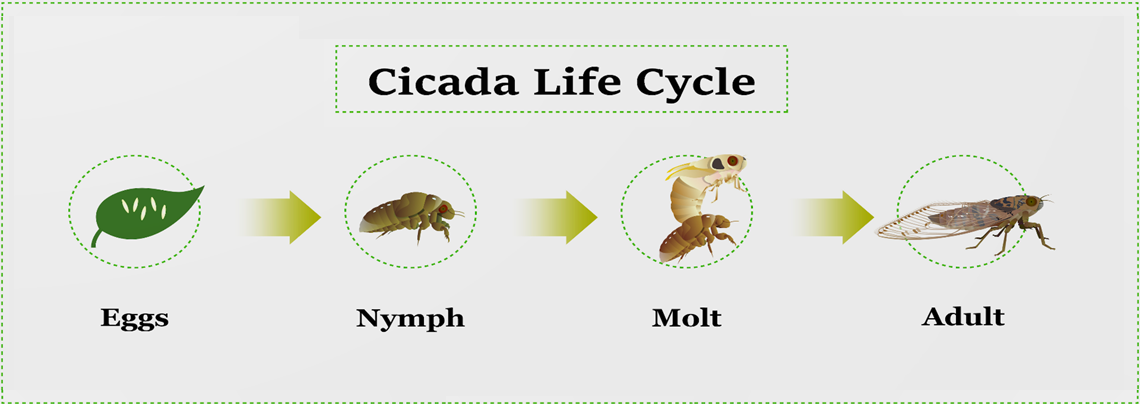
This year’s big brood of cicada has been living underground for 17 years and will emerge in bulk. Though this won’t happen everywhere, the cicada population can be as dense as 1.5 million cicadas per acre.
 In fact, the cicadas were so dense in the D.C. area that they appeared on radar. According to The Washington Post, “weather radars appeared extra cluttered, the radar showing shades usually associated with light rain or snow. That prompted the National Weather Service to tweet about an unusual “biological” signal appearing on their Sterling, Va.-based radar.”
In fact, the cicadas were so dense in the D.C. area that they appeared on radar. According to The Washington Post, “weather radars appeared extra cluttered, the radar showing shades usually associated with light rain or snow. That prompted the National Weather Service to tweet about an unusual “biological” signal appearing on their Sterling, Va.-based radar.”
The cicadas were born from eggs laid in trees 17 years ago. Then the nymph stage bugs drop to the ground and burrow under the dirt.
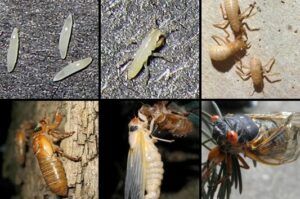 They’ll stay underground for an amount of time determined by their species. There are 3,000 different types of cicada species, most emerge every 2 to 5 years. There is one species that will emerge after 13 years and Brood X takes 17 years. During the time underground they are maturing and feeding on tree roots.
They’ll stay underground for an amount of time determined by their species. There are 3,000 different types of cicada species, most emerge every 2 to 5 years. There is one species that will emerge after 13 years and Brood X takes 17 years. During the time underground they are maturing and feeding on tree roots.
When the dirt reaches a temperature of about 64 degrees, at a depth of 12 to 18 inches, the nymph stage insect starts burrowing to the surface. There is growing evidence that global temperature fluctuation has started to affect the cicada’s cycle.
The nymph climbs the closest vertical surface and molts into it’s adult stage. As they break through their nymph shell their body is white and soft. It takes a few hours for the body to harden and darken to blueish-black.
After a few days, the cicada can fly and make that “cicada sound”. Only the males make the sound and each species is slightly different. It’s purpose is to attract a mate and start the cycle over.
The cicada will live in it’s noisy adult stage for only about 3 to 4 weeks. They are often on the ground in their last, dying stage when your dog happens upon them.
2019 cicadas were more dangerous
A few years ago there was a crop of cicadas that acquired a fungus while underground. This affected their behavior and gave them the nickname of “zombie” cicadas.
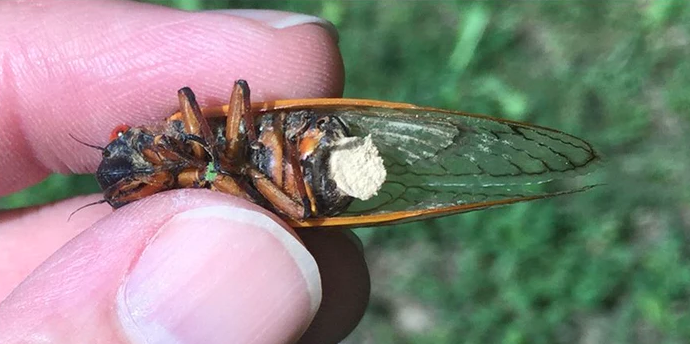
The fungus attacked the cicadas abdomen, limbs, and genitals, and drove them into a mating frenzy. Eventually, their lower body disintegrated and they died.
The compounds in the fungus contained powerful chemicals: psilocybin (the active ingredient in “magic mushrooms”) and the stimulant cathinone. Cathinone is a type of amphetamine. Previously, cathinone has only been found in the khat plant.
I think eating these cicadas would’ve been very dangerous for any animal. I wonder if some dogs got high that year!
Sickening or safe?
A lot of dogs seem to like eating cicadas. They say some people consume them dried and ground-up or chocolate covered. I even heard they taste kind of like shrimp. Good source of protein they say.
 For the next month, I’m going to keep an eye out for my dogs finding cicadas. Though I like to see my pups amuse themselves with nature or other dogs, I want to keep the dog-puke and diarrhea to a minimum.
For the next month, I’m going to keep an eye out for my dogs finding cicadas. Though I like to see my pups amuse themselves with nature or other dogs, I want to keep the dog-puke and diarrhea to a minimum.
If you have any Brood X/dog stories please share below. Please don’t hesitate to contact me if I can be of any assistance.
AKC on cicadas link:

